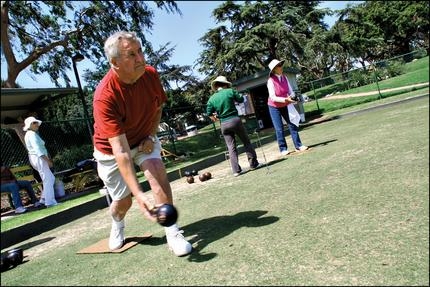
CITY HALL — If you like taking a dip at the Santa Monica Swim Center, are an avid lawn bowler or have a kid enrolled in a city-run sports league, be prepared to pay more come July 1.
The City Council on Tuesday agreed to raise fees for recreation programs and permits to use city facilities, a move that officials said is needed to stave off cuts as financial projections show a growing budget gap despite reductions in spending and a recently passed half percent sales tax hike.
Council’s decision followed a detailed report on City Hall’s financial health which included three scenarios, the worst case being a budget deficit as high as $26.3 million in five years.
The fee increases range from 25 cents to $218, changes that are expected to generate an additional $350,000 annually for City Hall.
“If we don’t start raising fees we will have to start cutting services or stop offering some programs,” said Mayor Pro Tem Gleam Davis. “We need to realize that as unfortunate as it is, we need to raise fees.”
Of the 33 programs and services provided by the Community and Cultural Services Department, 18 were subject to the fee increases. Of those, seven are subject to bumps that solely capture cost-of-living increases that have not been applied in previous years, said Barbara Stinchfield, director of Community and Cultural Services.
In addition to the fee increases, four new fees were approved, including a lawn bowling green maintenance fee, an administrative fee for community events, a private coaching fee and a lane fee for non-resident swim teams.
In preparing the increases, Stinchfield said her team was sensitive to the fact that the recession has hit some families hard. Her proposal to council aimed to preserve significant subsidies for programs that provide a “broad community benefit” — things like playground use, senior activities and enrollment in the Police Activities League, which would remain free — while relying more heavily on user fees to fund programs that serve a “targeted population” — like the community gardens, lawn bowling or use of a city park for a private function, which would see fee increases.
City staff also considered how recently each program’s fees were increased and what nearby cities charge for comparable programs in coming up with the recommendations, she said.
In most cases, the fee increases would lessen City Hall’s subsidy by only a few percentage points of overall program expenses. For the community gardens, for instance, the 25 percent fee increase, from $60 per plot per year to $75 per year, would result in only a 2 percent decrease in the share of the program’s cost covered by City Hall’s general fund, from 93 percent to 91 percent.
Stinchfield said City Hall provides about $940,000 in financial assistance to youth, with more than $844,000 supporting before and after-school programs.
“We have a financial assistance program that no other city has at our level, with almost $1 million a year,” Stinchfield said.
While opposition to the increases has been minimal, city staff did make one change at the request of residents. Instead of eliminating a discount for nonprofits, staff recommended a 50 percent discount for local groups wanting to rent city facilities.
Councilman Bobby Shriver was the only council member to vote against fee increases for recreational programs, saying those services should be provided for free given that Los Angeles County is park poor.
“I just have always had a soft spot for parks and recreation,” he said. “I buy [charging fees] for trash collection and water and some of the other services. … I think we are lucky that in Santa Monica we have the beach and the city planned well to have the parks it does, but we’re still pretty limited in things people can do.”
Shriver said the council has the power to pull money from other areas and invest in programs or services it believes are needed.
“It’s not really a zero sum game. It’s a choice game,” Shriver said. “It’s an unpleasant task, but it’s real.”
Councilman Kevin McKeown said he has sympathy for those who will be impacted by the fee increases, but he felt comfortable approving the new fees because of City Hall’s generous subsidies and financial assistance to those in need.
“Frankly, some of us can afford it while some of us can’t, but as a community we won’t be able to afford it if we don’t raise fees,” he said.
Councilman Bob Holbrook said if the economy improves in the next few years and more revenue is generated, there’s no reason why the council could not revisit the fees and possibly lower them.
kevinh@www.smdp.com







